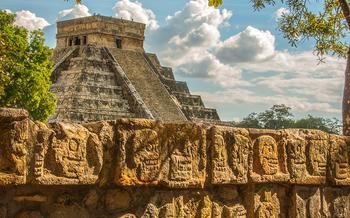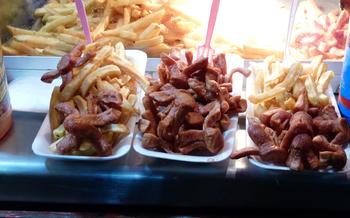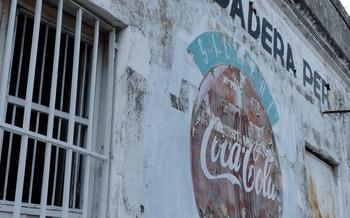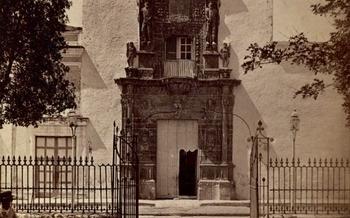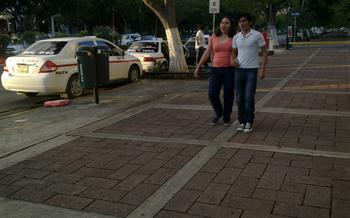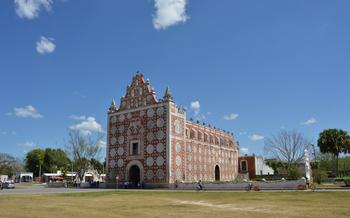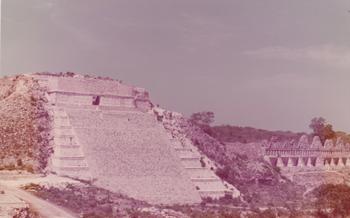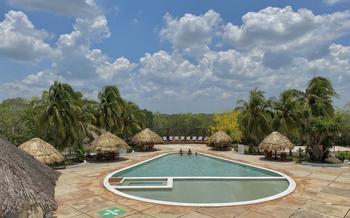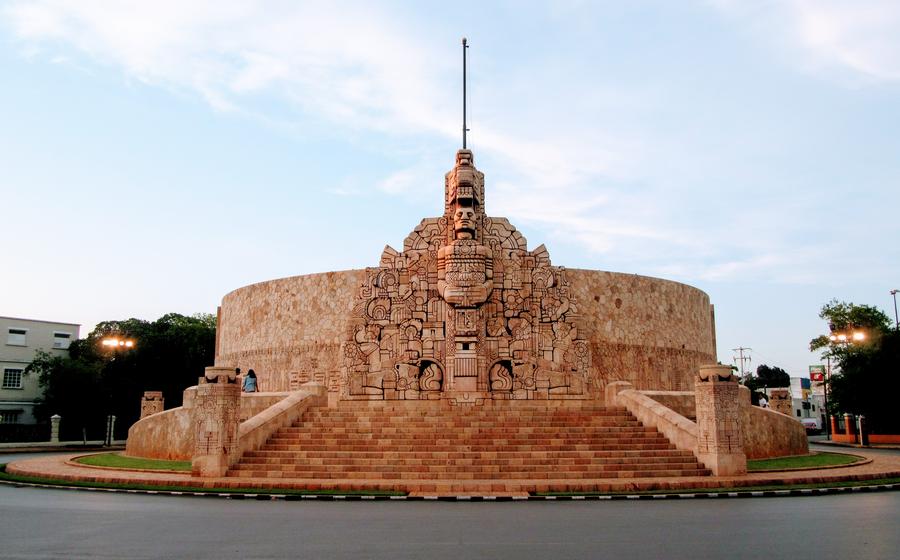
Monumento a la Patria
- Historical Significance
- Architectural Features
- Location and Accessibility
- Surrounding Area
- Visiting Hours and Fees
- Guided Tours
- Things to Do Nearby
- Photography and Videography
- Local Customs and Etiquette
- stands as a testament to the struggle for independence in Merida, a city that played a pivotal role in the liberation of Mexico from Spanish rule. The monument was commissioned in 1842, shortly after the end of the War of Independence, to honor the heroes who had fought for the city's freedom. It was designed by the architect Manuel Tolsá, who also designed the famous El Ángel de la Independencia in Mexico City.
- Local Cuisine and Delicacies
- Safety and Security
- Insider Tip: Unveiling the Hidden Gem
Historical Significance
The Monumento a la Patria stands as a proud testament to the indomitable spirit of Mexican independence. Its construction, commissioned by President Porfirio Díaz in 1906, marked the centennial of the pivotal "Grito de Dolores," the rallying cry that ignited the Mexican War of Independence in 18Designed by renowned Italian sculptor Emilio Amero, the monument was unveiled in 1910 amidst grand celebrations, symbolizing the nation's triumph over colonial rule and its rebirth as a sovereign state. The monument has since become a revered landmark, a constant reminder of the sacrifices and struggles that paved the way for Mexico's freedom.
Architectural Features
The Monumento a la Patria stands out for its unique architectural style, blending classical and contemporary elements. Its imposing structure is made of white limestone, quarried from nearby quarries, giving it a majestic and timeless appearance. The monument's design incorporates intricate details and sculptures that reflect the rich history and culture of Mexico.
At the base of the monument, a series of arches supports a platform adorned with reliefs depicting significant events in Mexican history, including the struggle for independence and the country's progress. The central column, rising from the platform, is adorned with intricate carvings and crowned by a bronze statue of a woman holding a laurel wreath, symbolizing victory and national pride.
The monument's design is further enhanced by its surrounding gardens, which feature colorful flowers, lush greenery, and fountains. These elements create a harmonious blend of natural beauty and architectural grandeur, providing visitors with a serene and picturesque setting to contemplate the monument's significance.
Location and Accessibility
The Monumento a la Patria is situated in the heart of Merida, on the Paseo de Montejo, one of the city's most iconic avenues. It stands proudly at the intersection of Calle 47 and Calle 50, surrounded by lush tropical vegetation and impressive colonial architecture.
Reaching the monument is a breeze, thanks to its central location. You can hop on the efficient public transportation system and take the bus or metro to the nearest stop, which is just a short walk away. Alternatively, you can opt for the convenience of a taxi or ride-sharing service to get you right to the monument's doorstep.
For those traveling by car, fear not; the monument boasts ample parking space, ensuring a hassle-free visit. Moreover, the site is fully accessible to visitors with disabilities, featuring ramps, elevators, and designated parking areas.
Surrounding Area
The Monumento a la Patria is situated in the heart of Merida's historic center, a vibrant and culturally rich neighborhood teeming with notable landmarks and attractions. Within a stone's throw of the monument, visitors can explore the majestic Catedral de San Ildefonso, a stunning example of 16th-century Spanish colonial architecture, and the Palacio de Gobierno, the seat of the state government, which houses beautiful murals depicting significant events in Yucatan's history.
A short stroll from the monument leads to the Plaza Grande, the city's main square, where locals and tourists alike gather to soak in the lively atmosphere. Here, visitors can admire the elegant porticoes, browse local artesanía (handicrafts) at the bustling market, and indulge in delicious regional cuisine at one of the many restaurants and cafes lining the square.
For those seeking a deeper immersion into Merida's rich history and culture, the Museo de la Ciudad de Merida, located just a few blocks from the monument, offers a fascinating journey through the city's past. The museum houses an impressive collection of artifacts, documents, and interactive exhibits that shed light on Merida's pre-Columbian, colonial, and modern eras.
The surrounding area is also a shopper's paradise, with a plethora of boutiques, art galleries, and souvenir shops catering to every taste and budget. Visitors can find everything from traditional Mayan handicrafts to contemporary fashion and jewelry, making it the perfect place to pick up unique mementos of their trip to Merida.
Visiting Hours and Fees
The Monumento a la Patria is open to the public seven days a week, from 9:00 AM to 6:00 PM. Admission is free of charge for all visitors. The monument is a popular tourist destination, so it is advisable to arrive early to avoid crowds, especially during peak season.
Guided tours are available in English and Spanish, and are led by knowledgeable and experienced guides who can provide insights into the history, architecture, and significance of the monument. Tours typically last for about an hour and can be booked in advance or on-site. There is a small fee for guided tours, but it is well worth the cost for a more immersive and informative experience.
Guided Tours
Enhance your visit to the Monumento a la Patria by booking a guided tour. Knowledgeable guides bring the monument's history, symbolism, and architectural features to life, providing insights that you might miss if exploring independently. Tours are available in various languages, including English, Spanish, and French.
Expect to learn about the monument's construction, the significance of its design, and the role it played in Mexico's history. Guides often share anecdotes and stories that bring the monument's past alive. They can also point out intricate details and sculptures that you might overlook on your own.
Guided tours typically last for about an hour and cost around $10-$15 per person. You can book tours through your hotel concierge, online platforms, or directly at the monument. Remember to book in advance, especially during peak tourist season, to secure your spot.
Things to Do Nearby
Beyond the Monumento a la Patria, the surrounding area offers a wealth of attractions and activities for visitors to explore. Within easy walking distance, you'll find the Plaza Grande, the heart of Merida's historic center. Here, you can admire the stunning Catedral de San Ildefonso, stroll through the lively markets, and soak up the vibrant atmosphere of this bustling square.
For a glimpse into Merida's rich cultural heritage, head to the Museo de la Ciudad de Merida, housed in a beautiful 19th-century mansion. The museum showcases a fascinating collection of artifacts and exhibits that trace the city's history from its pre-Columbian roots to the present day.
If you're looking for a unique shopping experience, wander through the narrow streets of the Paseo de Montejo, Merida's main boulevard. This elegant avenue is lined with historic mansions, charming boutiques, and art galleries, offering a delightful mix of traditional and modern shopping.
For those who enjoy outdoor activities, the Parque de las Americas, located just a short walk from the monument, provides a tranquil oasis amidst the city's hustle and bustle. This sprawling park features lush gardens, walking trails, and a children's playground, making it a great place to relax, play, or simply enjoy a leisurely stroll.
To delve deeper into Merida's culinary scene, take a cooking class and learn to prepare traditional Yucatecan dishes using fresh, local ingredients. Several cooking schools in the city offer classes for all skill levels, providing a fun and interactive way to experience the region's unique flavors.
Photography and Videography
The Monumento a la Patria offers a stunning backdrop for photography and videography. With its intricate details, imposing size, and historical significance, the monument is a photographer's dream. The best spots for capturing the monument's beauty are from the base, where you can get a full view of its grandeur, and from the surrounding gardens, which offer a more intimate perspective. Be sure to take advantage of the different lighting conditions throughout the day to capture the monument in its most flattering light.
While photography and videography are generally permitted at the monument, there are a few restrictions to keep in mind. The use of tripods and other professional equipment may require a permit, so it's best to check with the local authorities beforehand. Additionally, flash photography is not allowed inside the monument, as it can damage the delicate artwork. By following these guidelines, you can ensure that you capture the beauty of the Monumento a la Patria while respecting its historical significance.
Local Customs and Etiquette
When visiting the Monumento a la Patria, it is important to be mindful of local customs and etiquette to ensure a respectful and enjoyable experience.
Dress Code: Dress modestly and appropriately, avoiding revealing or overly casual attire. It is customary to cover your shoulders and knees when visiting religious or historical sites.
Behavior: Be respectful and mindful of your surroundings. Avoid loud noises, boisterous behavior, or gestures that may be considered offensive.
Photography and Videography: While photography and videography are generally permitted, it is important to be respectful of other visitors and the monument itself. Avoid using flash photography or tripods that may obstruct the views of others.
Local Traditions and Customs: Take the time to learn about local traditions and customs before your visit. This will help you avoid any misunderstandings or faux pas. For example, it is customary to greet people with a handshake or a nod of the head, and to say "buenos dias" (good morning) or "buenas tardes" (good afternoon) when entering a shop or restaurant.
stands as a testament to the struggle for independence in Merida, a city that played a pivotal role in the liberation of Mexico from Spanish rule. The monument was commissioned in 1842, shortly after the end of the War of Independence, to honor the heroes who had fought for the city's freedom. It was designed by the architect Manuel Tolsá, who also designed the famous El Ángel de la Independencia in Mexico City.
The construction of the monument began in 1843 and was completed in 185It was inaugurated on September 16, 1856, the anniversary of the beginning of the War of Independence. The monument quickly became a symbol of the city's independence and a source of pride for its citizens. It has been declared a national monument and is one of the most important landmarks in Merida.
Local Cuisine and Delicacies
Merida, the vibrant capital of Yucatan, is a culinary paradise that offers a tantalizing blend of Maya, Spanish, and Caribbean flavors. When visiting the Monumento a la Patria, be sure to embark on a culinary adventure to savor the authentic tastes of this region.
Stroll through the bustling Mercado Lucas de Galvez, located just a few blocks from the monument. This vibrant market is a haven for foodies, where you can find an array of fresh produce, spices, and local delicacies. Indulge in the velvety richness of cochinita pibil, a slow-roasted pork dish infused with achiote paste and wrapped in banana leaves. Sample the tangy flavors of panuchos, crispy tortillas topped with refried beans, shredded turkey, and a pickled red onion salsa.
Don't miss the opportunity to try salbutes, which are similar to panuchos but topped with a generous layer of guacamole and a sprinkling of fresh tomatoes. For a sweet treat, try the marquesitas, crispy crepes filled with a variety of fillings such as Nutella, cajeta (goat's milk caramel), or fruit.
For a sit-down dining experience, head to one of the many restaurants in the area. La Chaya Maya is a popular choice, offering a refined take on traditional Yucatecan cuisine. Savor the flavors of poc chuc, grilled pork tenderloin marinated in citrus and achiote, or try the sikil pak, a refreshing pumpkin seed dip served with crispy tortilla chips.
No visit to Merida is complete without trying the local beverages. Horchata, a sweet and creamy drink made from rice, cinnamon, and vanilla, is a refreshing choice. For a taste of the tropics, try the agua de Jamaica, a hibiscus flower tea that is both tart and flavorful.
Remember to embrace the Yucatecan tradition of "compartir", which means sharing food with others. It's a great way to sample a variety of dishes and connect with the locals. With its vibrant flavors and warm hospitality, Merida is a culinary destination that will leave you wanting more.
Safety and Security
Merida is generally considered a safe city for tourists, with a low crime rate. However, as with any travel destination, it is important to exercise caution and be aware of your surroundings. When visiting the Monumento a la Patria, be sure to keep your valuables close and avoid displaying large amounts of cash. Stick to well-lit areas and avoid walking alone at night. If you have any concerns or need assistance, don't hesitate to approach a police officer or security guard. In case of an emergency, dial 911 or the local emergency number. Remember to make a copy of your important travel documents and keep them in a separate location from the originals.
Insider Tip: Unveiling the Hidden Gem
Venturing a few steps beyond the majestic Monumento a la Patria, you'll stumble upon a hidden gem that often escapes the radar of ordinary tourists. Nestled amidst the tranquil surroundings of the park, discover a small, unassuming cafe named "La Perla de Merida." This culinary haven serves up a tantalizing array of traditional Yucatecan dishes, infused with the flavors and aromas of the region. Savor the delectable Cochinita Pibil, a slow-cooked pork delicacy marinated in achiote and wrapped in banana leaves, or indulge in the velvety richness of the Sopa de Lima, a zesty lime soup brimming with fresh seafood. As you relish these culinary delights, immerse yourself in the warm ambiance of the cafe, adorned with vibrant murals depicting scenes from Merida's vibrant history. Embrace the local tradition of "sobremesa," lingering over your meal and engaging in lively conversations with fellow diners. La Perla de Merida offers a unique opportunity to savor authentic Yucatecan cuisine while immersing yourself in the city's cultural tapestry.
